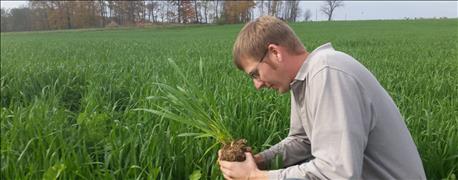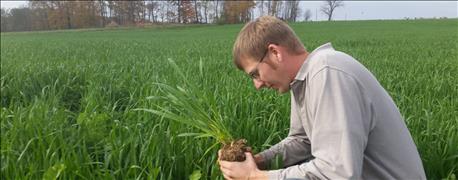November 15, 2016

“People’s interest in drone usage on farms is beyond the scope of the technology’s ability to deliver,” says Terry Griffin, assistant professor in the Department of Agricultural Economics at Kansas State University. With the public’s fascination with drones at a peak, agricultural researchers are questioning the viability and necessity of implementing drones for crop analysis.

AGRONOMIST NEEDED: The work that Matt Stine of Nicholson Consulting Services LLC, Greencastle, does can be complemented by drones. However, the agronomist is still crucial. (Photo provided by Matt Stine)
It takes minutes for a drone to capture thousands of field images, but hours for a knowledgeable person to sift through and determine how to use these images. “Buying a drone is simple, like going to Walmart and buying a toy,” says Griffin, a precision ag technology and big data researcher. “The difficulties arise when weighing the human capital costs associated with making use of the data.”
Wants vs. reality
Many farmers want to fly a drone across a field and receive a yield assessment or nitrogen recommendation, says Ray Asebedo, assistant professor of precision agriculture in the Department of Agronomy at KSU. However, the algorithms that are required to analyze and process data for making recommendations aren’t fully developed.
“I can’t support a farmer spending $20,000 on a drone to go fly fields, simply because there aren’t enough agronomic outputs yet to give them what they want,” says Asebedo. “Extensive research and development needs to be done to get the artificial intelligence up to snuff to do that.”
Asebedo predicts that five years from now, most areas will have algorithms that can be integrated into drones, but even then, he believes that agronomists will always serve as middlemen who interpret data and finalize recommendations. “We’re building drones and the robotics to be management tools to assist agronomists and make farm operations more efficient, increase profit per acre and reduce environmental impact,” says Asebedo.
Ultimately, the way in which a drone is integrated and used on a farm dictates the technology’s performance and return on investment. Drones can increase efficiency by finding malfunctioning irrigation nozzles, locating loose bolts on grain bins and serving as near-perfect substitutes for other platforms that collect field imagery. Drone technology also has the potential to improve crop-monitoring programs if early detection of crop stress is used to maintain yields.
According to Asebedo, a farmer can buy a drone in the $700 to $1,200 range and get a bird’s-eye view of his or her field in order to pinpoint problem areas for further analysis by an agronomist.
Timely flights
However, if a farmer doesn’t implement routine drone flights at important yield-determining growth stages throughout the season, he or she runs the risk of capturing images when it is too late to recover maximum yield from stressed crops. “Drones often deliver results like an autopsy,” says Griffin. “They can give results that make a farmer reactive — not proactive.”
Because of the newness of the technology and gaps in data analysis, there is not successful research to support the in-season use of drone imagery for crop production, according to Griffin.
The future of drone usage is uncertain. The only certainty is that more time, research and success stories will be needed before determining if drones deserve a role on every farm.
Carroll is a senior in ag communication at Purdue University. She writes from West Lafayette.
You May Also Like




